EN 50128 Software Regression Testing of Railway Signaling Systems
The European standard EN 50128 is a cornerstone for ensuring the safety and reliability of software used in railway signaling systems. This standard provides guidelines on how to develop, verify, and validate safety-critical software, with particular emphasis on regression testing. Regression testing ensures that new changes or updates do not disrupt existing functionality within complex systems like those used in railway signaling.
In the context of railway transportation, where system failures can lead to severe accidents, ensuring that any new development does not compromise the integrity and reliability of existing software is paramount. This service focuses on conducting regression testing based on EN 50128, which involves a series of rigorous checks designed to catch errors introduced by recent changes or updates.
The process begins with a thorough understanding of the current system architecture and requirements. Our team uses this information to design test cases that not only cover new functionalities but also ensure that all pre-existing features remain operational. The testing phase involves executing these test cases systematically, monitoring for any anomalies, and documenting them meticulously.
The success of EN 50128 compliance is heavily reliant on the quality of instrumentation used during testing. We utilize state-of-the-art tools and software that can simulate various real-world scenarios to test the system's robustness under different conditions. Our expertise lies in configuring these instruments correctly, ensuring accurate and reliable data collection.
Once testing is complete, our team provides detailed reports outlining all findings, including any issues discovered during regression testing along with recommendations for corrective actions. These reports serve as valuable resources not only for immediate issue resolution but also for future development cycles, helping to build a more resilient system over time.
The importance of EN 50128 in railway signaling cannot be overstated given the critical nature of these systems and their impact on public safety. By adhering strictly to this standard, we contribute significantly to enhancing overall rail safety while ensuring compliance with international regulations.
Applied Standards
| Standard | Description |
|---|---|
| EN 50128 | European standard for software testing and validation of safety-critical signaling systems in railway applications. |
Scope and Methodology
The scope of EN 50128 software regression testing encompasses the entire lifecycle of a safety-critical signaling system. This includes pre-release, post-release, and continuous integration phases where new code is introduced into an existing system.
The methodology involves several key steps:
- Defining test scenarios that cover all aspects of the software's functionality
- Executing automated tests to check for regressions immediately after changes are made
- Analyzing results and addressing any discrepancies found
- Re-running tests periodically to ensure ongoing stability
We employ a combination of manual and automated testing techniques tailored specifically for the complexities involved in railway signaling systems. Our approach ensures that even minute changes are caught early, preventing potential cascading failures that could affect critical operations.
The success of our EN 50128 compliance efforts is measured by several key performance indicators (KPIs), including but not limited to:
- Number of defects identified and corrected
- Time taken from change implementation to full system verification
- Customer satisfaction levels regarding testing outcomes
Competitive Advantage and Market Impact
Adhering strictly to EN 50128 not only ensures high standards of quality but also provides a competitive edge in an increasingly stringent regulatory environment. By demonstrating our commitment to safety and reliability, we attract clients who value these qualities highly.
Our service directly impacts the market by contributing positively towards reducing risks associated with software failures in railway signaling systems. This helps maintain public trust in rail transport while promoting safer travel experiences for passengers worldwide.





